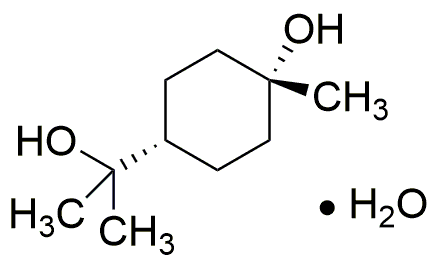Terpin monohydrate is widely utilized in research focused on:
- Pharmaceuticals: It serves as a key ingredient in formulations for cough syrups and expectorants, helping to relieve respiratory issues by acting as a mucolytic agent.
- Cosmetics: This compound is incorporated into skincare products for its moisturizing properties, enhancing skin hydration and providing a soothing effect.
- Food Industry: Used as a flavoring agent, it adds a pleasant aroma and taste to various food products, making it popular in the formulation of candies and baked goods.
- Aromatherapy: Terpin monohydrate is used in essential oils and diffusers, promoting relaxation and well-being through its calming scent.
- Cleaning Products: Its antimicrobial properties make it effective in household cleaners, providing a natural alternative for disinfecting surfaces.
General Information
Properties
Safety and Regulations
Applications
Terpin monohydrate is widely utilized in research focused on:
- Pharmaceuticals: It serves as a key ingredient in formulations for cough syrups and expectorants, helping to relieve respiratory issues by acting as a mucolytic agent.
- Cosmetics: This compound is incorporated into skincare products for its moisturizing properties, enhancing skin hydration and providing a soothing effect.
- Food Industry: Used as a flavoring agent, it adds a pleasant aroma and taste to various food products, making it popular in the formulation of candies and baked goods.
- Aromatherapy: Terpin monohydrate is used in essential oils and diffusers, promoting relaxation and well-being through its calming scent.
- Cleaning Products: Its antimicrobial properties make it effective in household cleaners, providing a natural alternative for disinfecting surfaces.
Documents
Safety Data Sheets (SDS)
The SDS provides comprehensive safety information on handling, storage, and disposal of the product.
Product Specification (PS)
The PS provides a comprehensive breakdown of the product’s properties, including chemical composition, physical state, purity, and storage requirements. It also details acceptable quality ranges and the product's intended applications.
Certificates of Analysis (COA)
Search for Certificates of Analysis (COA) by entering the products Lot Number. Lot and Batch Numbers can be found on a product’s label following the words ‘Lot’ or ‘Batch’.
*Catalog Number
*Lot Number
Certificates Of Origin (COO)
This COO confirms the country where the product was manufactured, and also details the materials and components used in it and whether it is derived from natural, synthetic, or other specific sources. This certificate may be required for customs, trade, and regulatory compliance.
*Catalog Number
*Lot Number
Safety Data Sheets (SDS)
The SDS provides comprehensive safety information on handling, storage, and disposal of the product.
DownloadProduct Specification (PS)
The PS provides a comprehensive breakdown of the product’s properties, including chemical composition, physical state, purity, and storage requirements. It also details acceptable quality ranges and the product's intended applications.
DownloadCertificates of Analysis (COA)
Search for Certificates of Analysis (COA) by entering the products Lot Number. Lot and Batch Numbers can be found on a product’s label following the words ‘Lot’ or ‘Batch’.
*Catalog Number
*Lot Number
Certificates Of Origin (COO)
This COO confirms the country where the product was manufactured, and also details the materials and components used in it and whether it is derived from natural, synthetic, or other specific sources. This certificate may be required for customs, trade, and regulatory compliance.


